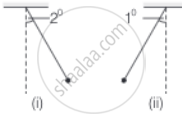Advertisements
Advertisements
प्रश्न
Consider a pair of identical pendulums, which oscillate with equal amplitude independently such that when one pendulum is at its extreme position making an angle of 2° to the right with the vertical, the other pendulum makes an angle of 1° to the left of the vertical. What is the phase difference between the pendulums?
उत्तर
Consider the situations shown in the diagram (i) and (ii)

Assuming the two pendulums follow the following functions of their angular displacements
`θ_1 = θ_0 sin(ωt + phi_1)` .......(i)
And `θ_2 = θ_0 sin(ωt + phi_2)` .......(ii)
As it is given amplitude and time period are equal but phases being different.
Now, for the first pendulum at any time t
`θ_1 = + θ_0` .....[Right extreme]
From equation (i), we get
⇒ `θ_0 = θ_0 sin(ωt + phi_1)` or 1 = `sin(θt + phi_1)`
⇒ `sin pi/2 = sin(ωt + phi_1)`
or `(ωt + phi_1) = pi/2` ......(iii)
Similarly, at the same instant t for pendulum second, we have `θ_2 = - θ_0/2` where θ0 = 2° is the angular amplitude of the first pendulum. For the second pendulum, the angular displacement is one degree, therefore `θ_2 = θ_0/2` and a negative sign is taken to show for being left to mean position.
From equation (ii), then `- θ_0/2 = θ_0 sin(ωt + phi_2)`
⇒ `sin(ωt + phi_2) = - 1/2`
⇒ `(ωt + phi_2) = - pi/6 or (7pi)/6`
or `(ωt + phi_2) = - pi/6 or (7pi)/6` ......(iv)
From equations (iv) and (iii), the difference in phases
`(ωt + phi_2) - (ωt + phi_2) = (7pi)/6 - pi/2`
= `(7pi - 3pi)/6`
= `(4pi)/6`
Or `(phi_2 - phi_1) = (4pi)/6 = (2pi)/3` = 120°
APPEARS IN
संबंधित प्रश्न
When the length of a simple pendulum is decreased by 20 cm, the period changes by 10%. Find the original length of the pendulum.
The phase difference between displacement and acceleration of a particle performing S.H.M. is _______.
(A) `pi/2rad`
(B) π rad
(C) 2π rad
(D)`(3pi)/2rad`
The acceleration due to gravity on the surface of moon is 1.7 ms–2. What is the time period of a simple pendulum on the surface of moon if its time period on the surface of earth is 3.5 s? (g on the surface of earth is 9.8 ms–2)
Answer the following questions:
A man with a wristwatch on his hand falls from the top of a tower. Does the watch give correct time during the free fall?
A simple pendulum of length l and having a bob of mass M is suspended in a car. The car is moving on a circular track of radius R with a uniform speed v. If the pendulum makes small oscillations in a radial direction about its equilibrium position, what will be its time period?
A mass attached to a spring is free to oscillate, with angular velocity ω, in a horizontal plane without friction or damping. It is pulled to a distance x0 and pushed towards the centre with a velocity v0 at time t = 0. Determine the amplitude of the resulting oscillations in terms of the parameters ω, x0 and v0. [Hint: Start with the equation x = acos (ωt+θ) and note that the initial velocity is negative.]
Define practical simple pendulum
Show that motion of bob of the pendulum with small amplitude is linear S.H.M. Hence obtain an expression for its period. What are the factors on which its period depends?
The relation between acceleration and displacement of four particles are given below: Which one of the particles is executing simple harmonic motion?
A body of mass m is situated in a potential field U(x) = U0 (1 – cos αx) when U0 and α are constants. Find the time period of small oscillations.
